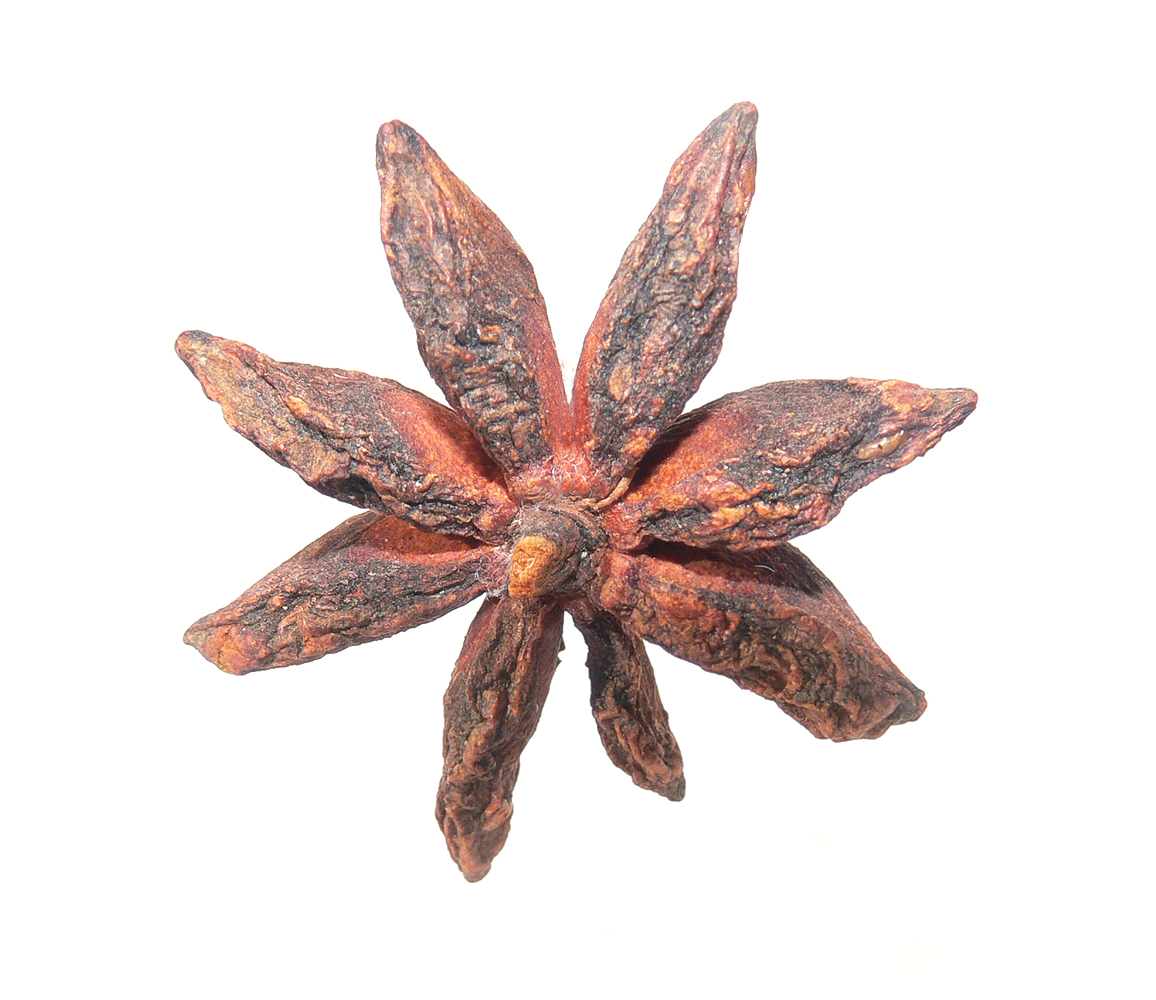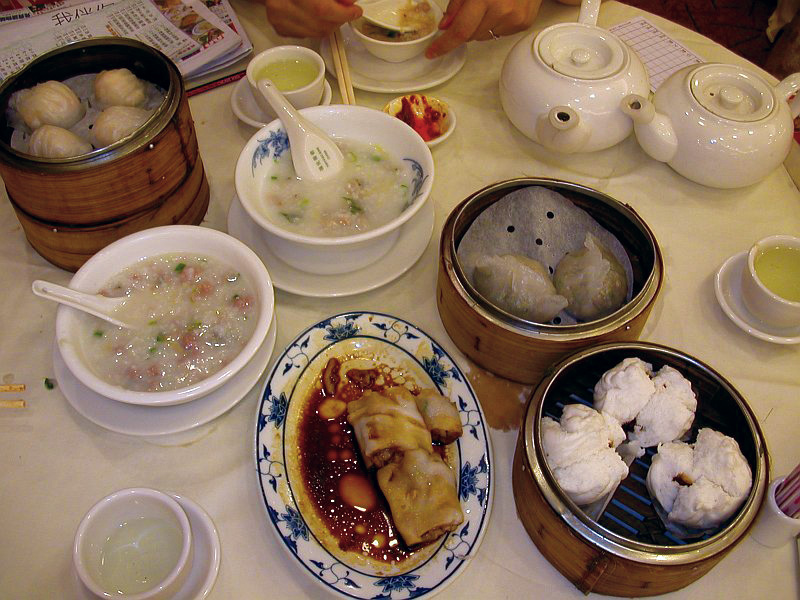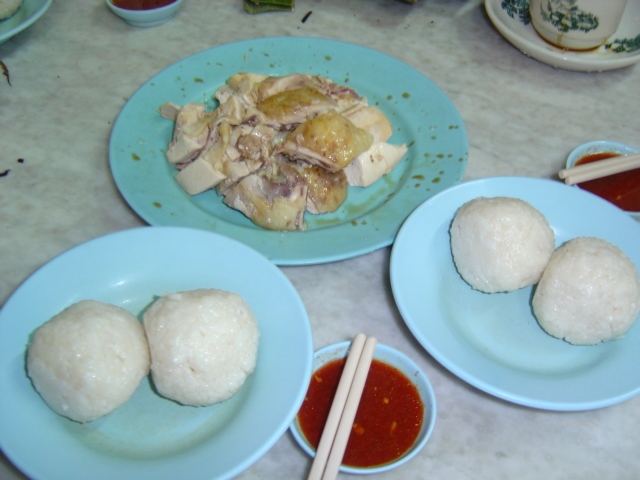|
White Cut Chicken
White cut chicken or white sliced chicken () is a type of ''siu mei''. Unlike most other meats in the ''siu mei'' category, this particular dish is not roasted, but steamed. The dish is common to the cultures of Southern China, including Guangdong, Fujian and Hong Kong. Preparation The chicken is salt-marinated and cooked in its entirety in either plain in hot water or chicken broth with ginger. Other variations season the cooking liquid with additional ingredients, such as the white part of the green onion, cilantro stems or star anise. When the water starts to boil, the heat is turned off, allowing the chicken to cook in the residual heat for around 30 minutes. The chicken's skin will remain nearly white in color, and the meat will be quite tender and juicy. The dish can be served "rare," in which the meat is cooked thoroughly but a pinkish dark red blood is secreted from the bones. This is a more traditional version of white cut chicken that is seldom served in Chinese restau ... [...More Info...] [...Related Items...] OR: [Wikipedia] [Google] [Baidu] |
China
China, officially the People's Republic of China (PRC), is a country in East Asia. It is the world's most populous country, with a population exceeding 1.4 billion, slightly ahead of India. China spans the equivalent of five time zones and borders fourteen countries by land, the most of any country in the world, tied with Russia. Covering an area of approximately , it is the world's third largest country by total land area. The country consists of 22 provinces, five autonomous regions, four municipalities, and two Special Administrative Regions (Hong Kong and Macau). The national capital is Beijing, and the most populous city and financial center is Shanghai. Modern Chinese trace their origins to a cradle of civilization in the fertile basin of the Yellow River in the North China Plain. The semi-legendary Xia dynasty in the 21st century BCE and the well-attested Shang and Zhou dynasties developed a bureaucratic political system to serve hereditary monarchies, or dyna ... [...More Info...] [...Related Items...] OR: [Wikipedia] [Google] [Baidu] |
Star Anise
''Illicium verum'' is a medium-sized evergreen tree native to northeast Vietnam and southwest China. A spice commonly called star anise, staranise, star anise seed, star aniseed, star of anise, Chinese star anise, or badian that closely resembles anise in flavor is obtained from the star-shaped pericarps of the fruit of ''I. verum'' which are harvested just before ripening. Star anise oil is a highly fragrant oil used in cooking, perfumery, soaps, toothpastes, mouthwashes, and skin creams. Until 2012, when they switched to using a bacterial source, Roche Pharmaceuticals used up to 90% of the world's annual star anise crop to produce shikimic acid, a chemical intermediate used in the synthesis of oseltamivir (Tamiflu). Etymology and nomenclature ''Illicium'' comes from the Latin ''illicio'' meaning "entice" or "seduce".Gledhill, David (2008). "The Names of Plants". Cambridge University Press. (hardback), (paperback). pp 210, 400 ''Verum'' means "true" or "genuine". The name ... [...More Info...] [...Related Items...] OR: [Wikipedia] [Google] [Baidu] |
Hong Kong Cuisine
Hong Kong cuisine is mainly influenced by Cantonese cuisine, European cuisines (especially British cuisine) and non-Cantonese Chinese cuisines (especially Hakka, Teochew, Hokkien and Shanghainese), as well as Japanese, Korean and Southeast Asian cuisines, due to Hong Kong's past as a British colony and a long history of being an international port of commerce. Complex combinations and international gourmet expertise have given Hong Kong the labels of "Gourmet Paradise" and "World's Fair of Food".Sterling, Richard. Chong, Elizabeth. Qin, Lushan Charles 001(2001). ''World Food Hong Kong''. Hong Kong: Lonely Planet Publishing. . Background Modern Hong Kong has a predominantly service-based economy, and restaurant businesses serve as a main economic contributor. With the fourth-densest population per square metre in the world and serving a population of 7 million, Hong Kong is host to a restaurant industry with intense competition. Due to its small geographical size, Hong Kong c ... [...More Info...] [...Related Items...] OR: [Wikipedia] [Google] [Baidu] |
Cantonese Cuisine
Cantonese or Guangdong cuisine, also known as Yue cuisine ( or ) is the cuisine of Guangdong province of China, particularly the provincial capital Guangzhou, and the surrounding regions in the Pearl River Delta including Hong Kong and Macau.Hsiung, Deh-Ta. Simonds, Nina. Lowe, Jason. 005(2005). The food of China: a journey for food lovers. Bay Books. . p17. Strictly speaking, Cantonese cuisine is the cuisine of Guangzhou or of Cantonese speakers, but it often includes the cooking styles of all the speakers of Yue Chinese languages in Guangdong. Scholars categorize Guangdong cuisine into three major groups based on the region's dialect: Cantonese, Hakka and Chaozhou cuisines. The Teochew cuisine and Hakka cuisine of Guangdong are considered their own styles, as is neighboring Guangxi's cuisine despite eastern Guangxi being considered culturally Cantonese due to the presence of ethnic Zhuang influences in the rest of the province. Cantonese cuisine is one of the Eight Cu ... [...More Info...] [...Related Items...] OR: [Wikipedia] [Google] [Baidu] |
List Of Chicken Dishes
This is a list of chicken dishes. Chicken is the most common type of poultry in the world, and was one of the first domesticated animals. Chicken is a major worldwide source of meat and eggs for human consumption. It is prepared as food in a wide variety of ways, varying by region and culture. The prevalence of chickens is due to almost the entire chicken being edible, and the ease of raising them. Chicken as a meat has been depicted in Babylonian carvings from around 600 BC. Chicken was one of the most common meats available in the Middle Ages. It was eaten over most of the Eastern hemisphere and several different numbers and kinds of chicken such as c, aprons, pullets , and hens were eaten. It was one of the basic ingredients in the so-called white dish, a stew usually consisting of chicken and fried onions cooked in milk and seasoned with spices and sugar. Chicken dishes * * * * * * * * * * * * * * * * * * * * * * * * * * * * * * * * ... [...More Info...] [...Related Items...] OR: [Wikipedia] [Google] [Baidu] |
Hainanese Chicken Rice
Hainanese chicken rice is a dish of poached chicken and seasoned rice, served with chilli sauce and usually with cucumber garnishes. It was created by immigrants from Hainan in southern China and adapted from the Hainanese dish Wenchang chicken. It is considered one of the national dishes of Singapore and is most commonly associated with Singaporean cuisine, being widely available in most food courts and hawker centres around the country. Variants of the dish can also be seen throughout Southeast Asia, particularly in Malaysia and Thailand, where it remains a culinary staple. History Hainanese chicken rice is a dish adapted from early Chinese immigrants originally from Hainan province in southern China. It is based on a well-known Hainanese dish called Wenchang chicken (), which is one of four important Hainan dishes dating to the Qin dynasty. The Hainanese in China traditionally used a specific breed, the Wenchang chicken, to make the dish. They would usually cook rice wi ... [...More Info...] [...Related Items...] OR: [Wikipedia] [Google] [Baidu] |
Fried Chicken
Fried chicken, also known as Southern fried chicken, is a dish consisting of chicken pieces that have been coated with seasoned flour or batter and pan-fried, deep fried, pressure fried, or air fried. The breading adds a crisp coating or crust to the exterior of the chicken while retaining juices in the meat. Broiler chickens are most commonly used. The first dish known to have been deep fried was fritters, which were popular in the European Middle Ages. However, the Scottish were the first Europeans to deep fry their chicken in fat (though without seasoning). Meanwhile, many West African peoples had traditions of seasoned fried chicken (though battering and cooking the chicken in palm oil). Scottish frying techniques and West African seasoning techniques were combined by enslaved Africans and African Americans in the American South. History The American English expression "fried chicken" was first recorded in the 1830s, and frequently appears in American cookbooks of ... [...More Info...] [...Related Items...] OR: [Wikipedia] [Google] [Baidu] |
Crispy Fried Chicken
Crispy fried chicken () is a standard dish in the Cantonese cuisine of southern China and Hong Kong.39World.39World.com." ''炸子鸡.'' Retrieved on 2008-11-19. The chicken is fried in such a way that the skin is extremely crunchy, but the white meat is relatively soft.Guangzhou Cuisine . Retrieved 2009-10-20. This is done by first the chicken in water with spices (e.g. , , |
Oyster Sauce
Oyster sauce describes a number of sauces made by cooking oysters. The most common in modern use is a viscous dark brown condiment made from oyster extracts,The Times, 22 January 1981; ''Cook Accidentally on purpose'' sugar, salt and water thickened with corn starch. Some versions may be darkened with caramel, though high-quality oyster sauce is naturally dark.BigOven Food DictionaryOyster sauce' It is commonly used in Chinese, Thai, Malay, Vietnamese, and Khmer cuisine. Production Oyster sauce production began in China no later than the mid-1870s. Oysters were boiled in three iron basins for half an hour then removed for drying on rattan either by sun or over a moderate fire. The water from the basins was reduced in a fourth basin to "a blackish sauce". Sea-water, salt and/or soy could be added. Today, many shortcuts have been made to create a similar flavor more quickly and at reduced cost. Oyster sauces today are usually made with a base of sugar and salt and thickened with ... [...More Info...] [...Related Items...] OR: [Wikipedia] [Google] [Baidu] |
Soy Sauce
Soy sauce (also called simply soy in American English and soya sauce in British English) is a liquid condiment of Chinese origin, traditionally made from a fermented paste of soybeans, roasted grain, brine, and '' Aspergillus oryzae'' or ''Aspergillus sojae'' molds. It is considered to contain a strong umami taste. Soy sauce in its current form was created about 2,200 years ago during the Western Han dynasty of ancient China, and it has spread throughout East and Southeast Asia where it is used in cooking and as a condiment. Use and storage Soy sauce can be added directly to food, and is used as a dip or salt flavor in cooking. It is often eaten with rice, noodles, and sushi or sashimi, or can also be mixed with ground wasabi for dipping. Bottles of soy sauce for salty seasoning of various foods are common on restaurant tables in many countries. Soy sauce can be stored at room temperature. History East Asia China Soy sauce (, ) is considered almost as old as soy p ... [...More Info...] [...Related Items...] OR: [Wikipedia] [Google] [Baidu] |
Hoisin Sauce
Hoisin sauce is a thick, fragrant sauce commonly used in Cantonese cuisine as a glaze for meat, an addition to stir fry, or as dipping sauce. It is dark-coloured in appearance and sweet and salty in taste. Although regional variants exist, hoisin sauce usually includes soybeans, fennel, red chili peppers, and garlic. Vinegar, five-spice powder, and sugar are also commonly added. Name The word ''hoisin'' is derived from the Chinese words for "seafood" (), although the sauce does not contain any seafood ingredients and is not commonly consumed with seafood. The reason for the name is "seafood flavour", a common adjective in Chinese cuisine, especially Sichuanese (" fish fragrant"). Ingredients The key ingredient of hoisin sauce is fermented soybean paste. Some hoisin sauce ingredients include starches such as sweet potato, wheat and rice, and water, sugar, soybeans, sesame seeds, white distilled vinegar, salt, garlic, red chili peppers, and sometimes preservatives or colorin ... [...More Info...] [...Related Items...] OR: [Wikipedia] [Google] [Baidu] |
Marination
Marinating is the process of soaking foods in a seasoned, often acidic, liquid before cooking. The origin of the word alludes to the use of brine (''aqua marina'' or sea water) in the pickling process, which led to the technique of adding flavor by immersion in liquid. The liquid in question, the marinade, can be either acidic (made with ingredients such as vinegar, lemon juice, or wine) or enzymatic (made with ingredients such as pineapple, papaya, yogurt, or ginger), or have a neutral pH. In addition to these ingredients, a marinade often contains oils, herbs, and spices to further flavor the food items. It is commonly used to flavor foods and to tenderize tougher cuts of meat. The process may last seconds or days. Marinades vary between different cuisines. Marinating is similar to brining, except that brining generally does not involve a significant amount of acid. It is also similar to pickling, except that pickling is generally done for much longer periods, primarily as a m ... [...More Info...] [...Related Items...] OR: [Wikipedia] [Google] [Baidu] |






